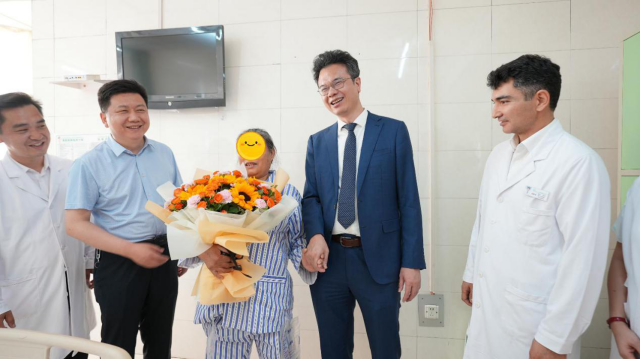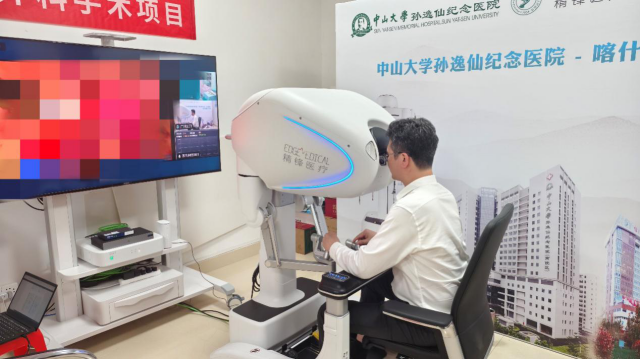In a heartfelt meeting at the Kashgar First People's Hospital, a nearly 60-year-old Uyghur woman expressed her gratitude to Dr. Lin Tianxin, who performed her surgery remotely from over 5,000 kilometers away in Guangdong. With tears of joy, she said, "Thank you, doctor; you have given me hope for a new life."
On July 23, Dr. Lin, Assistant to the President of Sun Yat-sen University and Professor of the Department of Urology at Sun Yat-sen Memorial Hospital, conducted a 5G-assisted robotic laparoscopic surgery for the patient, alleviating the suffering she had endured for several months.

On July 26, Dr. Lin (R2) visited the patient in the Kashgar First People's Hospital.
Dr. Lin has long held the vision of providing accessible healthcare for the people in southern Xinjiang. Since taking charge of Guangdong's medical assistance team to Xinjiang in November 2019, he has remained committed to improving the healthcare services in Xinjiang. Even after his official mission concluded in July 2021, he continued to support the development of healthcare in the region.
In March 2024, supported by Sun Yat-sen University, Dr. Lin initiated a remote robotic urological surgery project using 5G technology. A domestically produced laparoscopic surgical robot was transported to Kashgar in early July, marking a significant step forward in the medical technology collaboration between Guangdong and Xinjiang.
"The surgery felt no different from if I were there right beside the patient," Dr. Lin recounted as he operated the robot while monitoring real-time footage on a display screen. With the backing of strong 5G signals, there was virtually no lag during the procedure. Throughout the operation, he gave detailed explanations to the local medical team, turning a remote procedure into an interactive learning experience.

Dr. Lin performs remote surgery in Guangdong.
The surgery lasted over an hour with minimal blood loss. And the very next day, the patient was already able to walk, showcasing an excellent recovery.
According to Wu Yuanquan, Secretary of the Party Committee at the Kashgar First People's Hospital, the success of this remote robotic surgery was a groundbreaking achievement, enhancing the safety and efficiency of surgical options available to patients in southern Xinjiang.
During his stay in Xinjiang, Dr. Lin introduced over 100 new technologies and treatment models that significantly improved local healthcare outcomes. He reduced patient referral rates from 4.8% to 0.97% and increased the rescue success rate of critically ill patients from 50% to 98%.
Reflecting on the advancements in surgical robotics, Dr. Lin emphasized the importance of domestic innovation. He noted that the new surgical robots—equipped with features including naked-eye 3D vision, flexible endoscopic joints—offered substantial advantages for complex surgeries, yet much of the technology had been reliant on imports. Together with his mentor, they led efforts to develop homegrown surgical robots.
As a result of their efforts, the newly developed surgical robots were installed in 47 hospitals nationwide, which performed over 1,200 surgeries. The surgical robot was approved for import in the UAE as a medical device.
With plans to establish a training base for surgical talent in Xinjiang under the Belt and Road Initiative, Dr. Lin aimed to enhance local capabilities and facilitate knowledge exchange across Central Asia. His recent trip to Tajikistan for medical cooperation underscored this commitment as he sought to foster partnerships that would broaden access to quality healthcare resources in the region.
Link to the report: https://www.newsgd.com/node_99363c4f3b/a0e3b552c5.shtml



